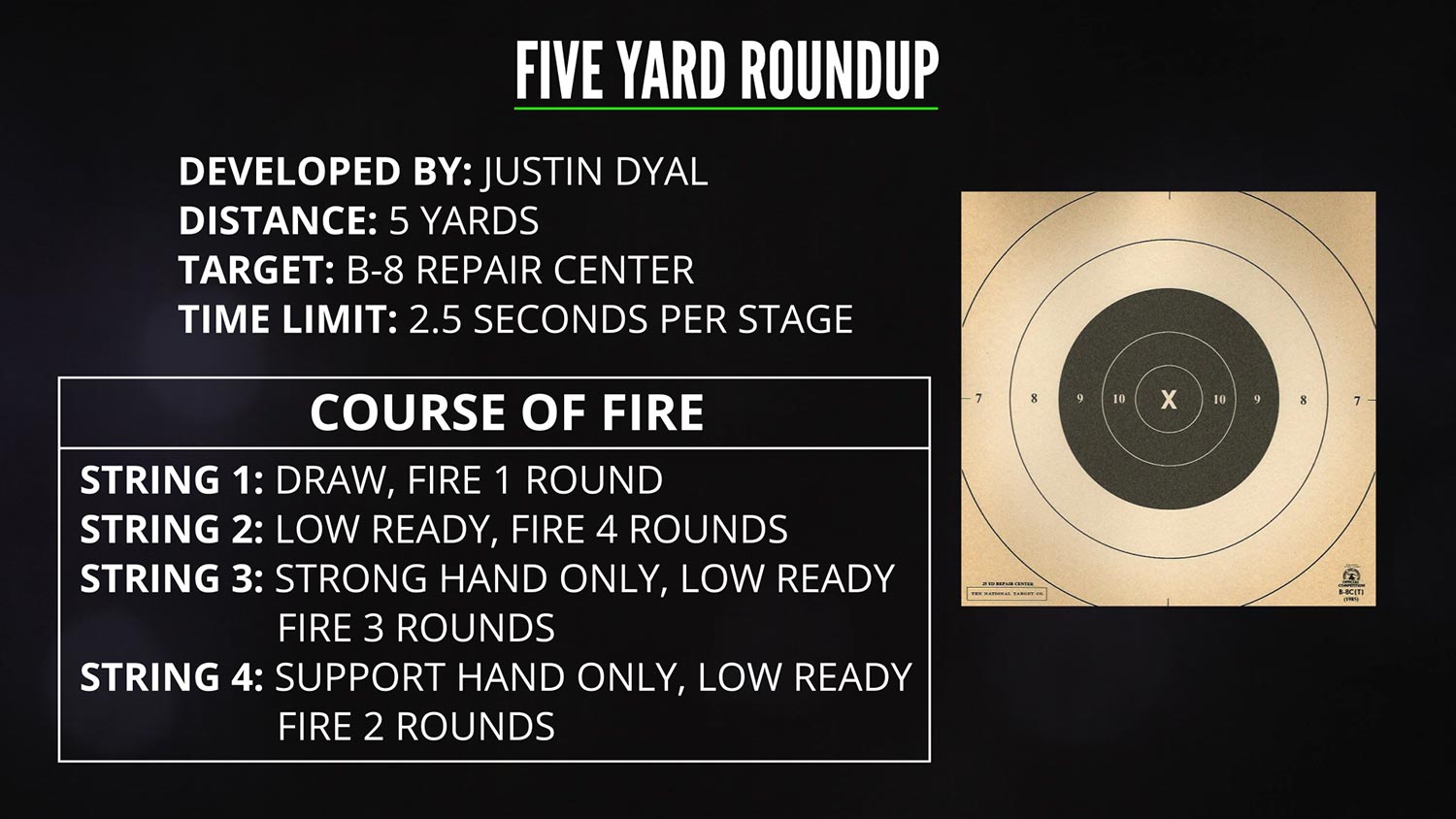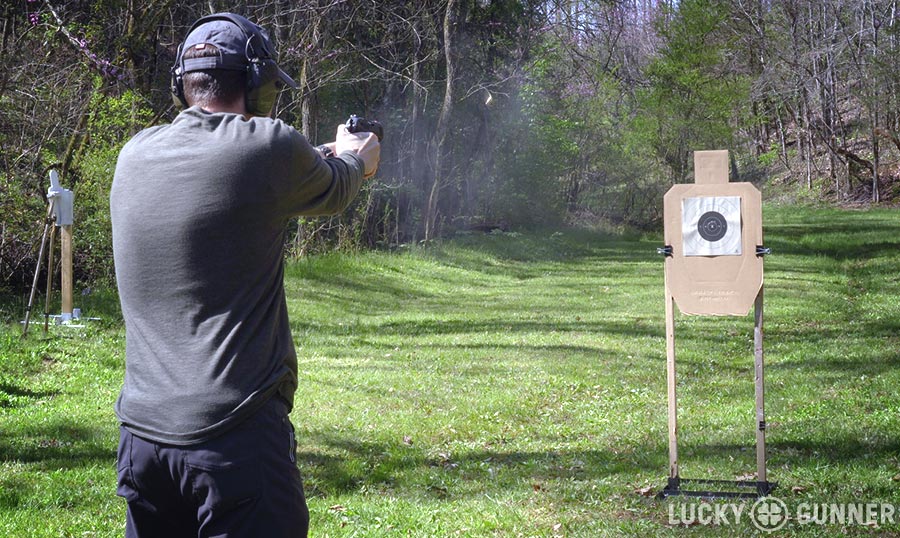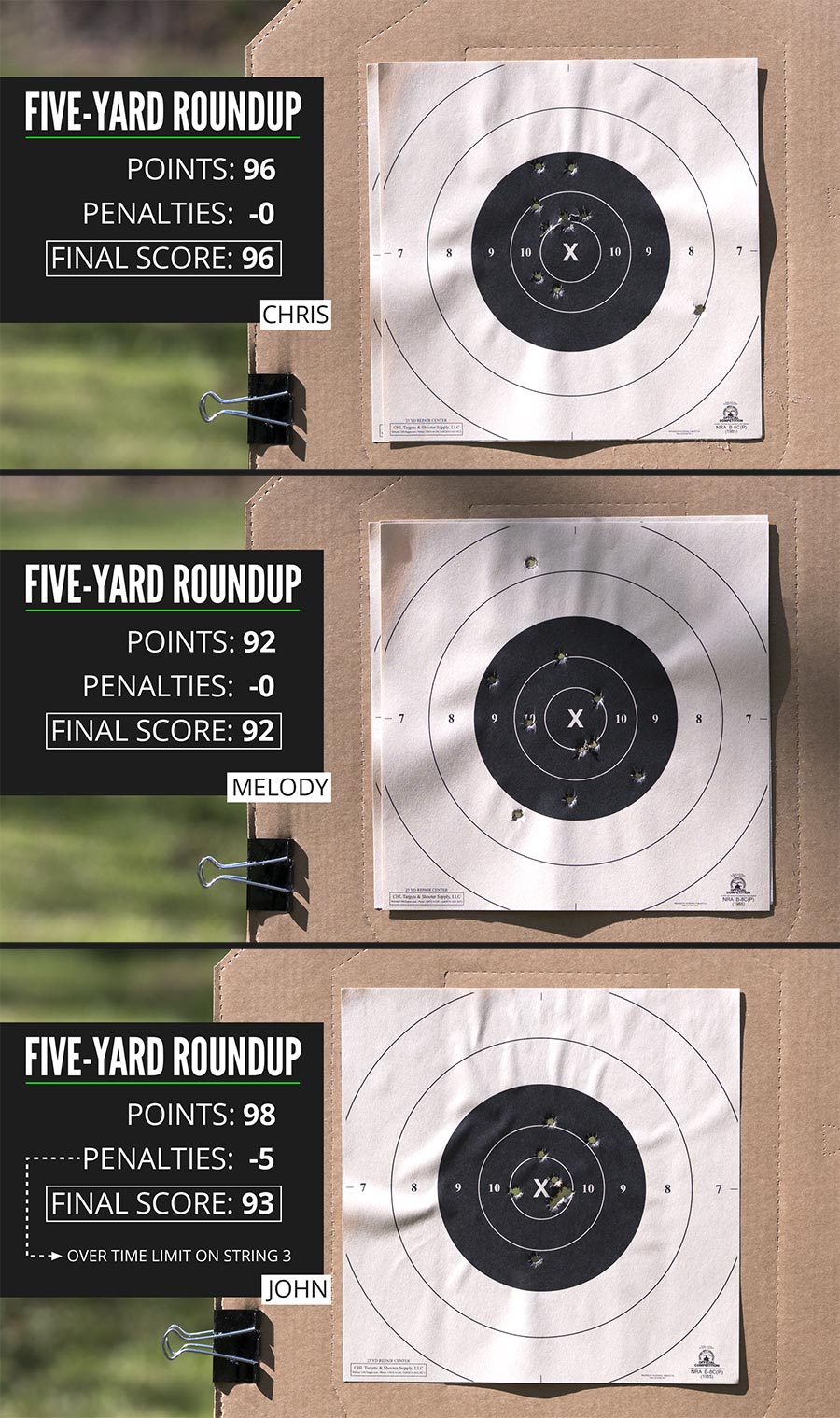Five yards. Four strings of fire. Ten rounds total. This quick and challenging shooting exercise is a great way to test your handgun skills. Watch the video for the details and to see our demos of the drill. As always, you can also scroll down and read the full transcript, instead.
Download and print your own B-8 bullseye target for this drill here (PDF).
CHRIS: Hey guys, Chris here from LuckyGunner.com. I’m here with John Johnston from Ballistic Radio and Citizens Defense Research. We’re doing another episode of our Start Shooting Better series. Today we’re doing the Five-Yard Roundup. This is a drill that both John and I got to do at the recent Rangemaster Tactical Conference. It’s a fun little short drill, but really challenging. John, why don’t you give us the outline of what that looks like.
JOHN: We’re going to start at five yards with a B-8 bullseye replacement center. You’ve got four strings of fire. The first is draw, fire 1. Second one is from low ready, at the commend, come up and fire four. Next one, from low ready, strong hand only, come up and fire three. The last one is weak hand only, from low ready, come up, fire two. All in 2.5 seconds.
CHRIS: So each string of fire, 2.5 seconds.
JOHN: Right.
CHRIS: And when we did it at the Rangemaster conference, they were using turning targets, so you can’t actually see the bullseye until you’re allowed to shoot it, so that adds an extra element to it. But you can do it with just a timer.
JOHN: Yeah, you can do it just with a timer. I had actually not shot that before, so the first time I had ever seen it or shot it was Rangemaster… cold. And I’m like “Ahhh!” So it was really fun, I’m glad we decided to do it today, too.
CHRIS: It’s kinda brutal becuase it’s only ten rounds, so if you throw one shot, your whole score is tanked. And that’s why they used it, I think. It was part of the match they had there, and it was to narrow it down to the top few shooters who would compete in the last leg of the match.
JOHN: Right. Justin Dyal came up with this and I was reading over his description of it that was published and he noted that a lot of people are either practicing at longer distances or giving themselves very generous time frames and that does not reflect the reality of what we’re seeing in encounters off of closed circuit TV and body cameras and stuff like that. It’s a lot harder than it seems and it’s very important that you stay aggressive on the gun the entire time, only see what you need to see, but you still need to get your hits.
The way it works is you have 2.5 seconds and a imperfect hit in 2.49 is better than a better hit in 2.5 because the way the drill is scored, every round you fire after the 2.5 second time limit, you get 5 points off. It’s an incredibly useful tool for figuring out where the line is between “I’m going as fast as I can” and “I’m still getting my hits.” The entire purpose of that is so if people find themselves in a close range encounter, they’re dominating that encounter from the very beginning instead of trying to catch up afterwards.
CHRIS: Let’s talk about one little technical aspect: low ready. There seems to be some confusion about what low ready is — some people have different interpretations of that. I interpret low ready as, basically, you start [at full extension] with the gun pointed below whatever your target is.
JOHN: Right, there are a couple of different variations of that depending on what you’re doing and where you’re doing it. The traditional one is that [your muzzle is pointed] just down at the base of the target. In a real world context, you want to be able to see the belt and hands — the waistline of whoever your pointing the gun at. You can run whatever variation you want to run, just make sure you’re not aimed in at the target when you start.
CHRIS: Alright, well that is the five yard roundup. Get out there, give it a try, and let us know how you do.
How does your score on the Five-Yard Roundup measure up to a pro shooter’s? Karl Rehn breaks it down in this post on his blog.





nice drill…chopped beard, nice… 🙂
This drill makes sense for all who carry. When I draw, I want to engage and stop the threat as quickly as possible.
hi –where can I get a “LUCKY GUNNER” hat… 🙂
I liked it. First time through the par time snuck up on me, and then my support hand just completely refused to play along and I dropped a shot entirely off the scoring rings–yeouch. The drill was great because it let me see where I don’t train–one handed shooting. I ran it a second time, and that one round of familiarity with what the 2.5 par time feels like was enough to help me get all my hits in time and score a 90 the second time through. I had some time left on a couple of the strings so I got a little arrogant and thought “Well, maybe I can do an advanced version” and so I did it with a 180 degree turn-around for the draw and shoot, then shot the 4 shot string from the holster, also the strong hand from the holster, and did the support hand with the 180 turn-around. Shot an 87 with two lousy shots from the support hand, but missed the par on the strong hand string so ended up scoring an 82. But I’m excited to train more one-handed shooting and revisit this in a month or so to see what kind of improvement I can gain. Thanks for all the cool drills and evals you keep posting!
As Wild Bill Hickok opined, “The three most important factors in a gunfight are 1) mindset, 2) accuracy, and 3) speed.”